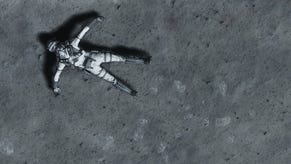Face-Off: Crysis
Can consoles run Crysis? Digital Foundry presents a triple-format analysis.
Outside of these differences, almost every other visual element is common to both consoles, with motion blur just as strong on gun reloads or quick pans, and the lightshafts falling down between illuminated tree leaves operating to equal effect. No doubt the more obvious dividing factor between the two versions is performance - as you'll see in the video below, the 360 commands a considerable advantage here in the same like-for-like cases.
For cut-scenes, it appears the 360 alternates between 30 and 32FPS. This is reminiscent of the effects a "fixed_time_step= -0.0335" line produces when put into the PC version's command console when attempting to force a capped frame rate. Although a pure capped 30FPS would have been preferable, this still makes for pleasantly smooth camera motion when it holds. Alas, both PS3 and 360 run at uncapped frame rates during gameplay, although this is rarely taken advantage of. Even by stripping the polygon count on distant objects, slow walks through densely packed thickets forces each respective frame-rate down to around 20FPS.
Performance doesn't improve during sequences of heavy gunplay either, with the general rule of thumb being that the PS3 will run at 5-10FPS less than its 360 counterpart under equivalent periods of strain. This is regardless of the situation, be it when particle and smoke effects are flying from an exploding tank, or when a hut collapses to charging truck. It's in these cases especially that performance takes its greatest hit, going all the way down to 12FPS on PS3 at one point.
There's no denying that the stealthy player will enjoy a much smoother gameplay experience on console, with plummets in frame rate during the wilder firefights often having a deteriorating effect on controller response too. For the majority of the game, however, performance can be classed as at least serviceable, and much of it here will vary greatly based on your style of play. It's a far cry from the "solid 25-30FPS" promised by the director, then, but the high quality camera motion blur can sometimes help to disguise those dropped frames at least from a visual standpoint.
In common with Crysis 2, this new console version of the original also supports stereoscopic 3D on both platforms, again using Crytek's reprojection technology. The basic notion here is very straightforward: the renderer works as normal in creating a standard 2D frame. However, the image is then processed based on information from the depth buffer into generating an alternative view for the second eye. These are then formatted into whatever 3D formats the console supports. In the case of PlayStation 3, it's packaged into the HDMI 1.4 format, offering full 720p resolution per eye, while Xbox 360 gets a side-by-side presentation with a resolution drop.
During the Crysis 2 multiplayer demo, we raised doubts about whether this was actually proper 3D or not, as it appeared that the frame was divided into three 2D planes - the HUD, the view weapon and everything else: easy on the eye for sure, but not even an approximation of true stereoscopy - more a diorama effect. With the final game, we did see some evidence of an interaxial (camera separation), but it was really apparent when the stereoscopic slider was set to a much higher setting.
In Crysis, it seems that it is now set to max by default and the result is that while this is far from the kind of truly immersive 3D experience you'd enjoy from say, Killzone 3, the fact is that the expansion of depth to the scene is quite pleasing to behold. As you can see from the Xbox 360 performance analysis on this page, it's also apparent that the impact to frame-rate is minimal - you retain the relative smoothness of the experience. The PlayStation 3 stereoscopic mode is just as good - more so in fact, as you get full native 720p thanks to the HDMI 1.4 implementation.
So all told, a clear preference has been made to optimise the console versions in favour of visual fidelity over performance, although this ultimately works out better for the 360 version. Of course, this remaster job has been about the perceived improvements to the player, which isn't necessarily an indication of the underlying technology running the game, but how deftly Crytek UK have worked around the limitations of the hardware at hand. A few years ago Digital Foundry speculated whether consoles could run Crysis, but the linear, closely-guarded structure of the sequel that eventually arrived to those formats didn't quite satisfy our curiosity.
But here we are, with a full sandbox island to play around with on consoles, just as we'd imagined it should look in the best case scenario. The real litmus test for us is being able to tear through a cluster of pine trees with a machine gun and, as you watch them tumble against each other, seeing the lightshafts flickering between the branches - it's a real achievement, and the Crysis experience in a nutshell for its many fans. The best part, though, is that not only do these results vindicate some of Cevat Yerli's bold claims, but they also do a fantastic job of demonstrating CryEngine 3's flexibility on console in the way its sequel could not.
Article by Thomas Morgan.















